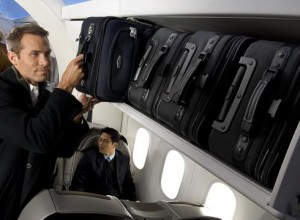With airlines always increasing the prices for checked baggage, so many people try to fit all of their travel items in one carry on suitcase. So while the whole plane is boarding, people are frantically trying to find an overhead bin that can fit their suitcases. The plane may be ready to take off, but the passengers are not all seated with their luggage stowed properly. American Airlines has caught on to that.
After coming in second to last in 2012 in terms of on-time performance, American Airlines decided they needed to change the way they boarded their passengers. Starting May 16th, passengers with small carry on items that can be stored on the floor will board first. Those with suitcases will follow. The hopes are that the new boarding procedure will reduce rolling suitcases causing blockage in the aisles while boarding. The jets can then back away from the gates quicker and help American Airlines improve their on -time arrival rate. In this past March, about 20% of U.S. airlines’ flights were delayed, about 7% of those flights were delayed due to late-arriving planes. A four week test showed that the new boarding procedure shaved an average of two minutes off of the flight loading, “which adds up,” said Daniel Bellavigna, American’s supervisor of continuous improvement.
That’s not the only problem American Airlines is having with their baggage. Half of the overhead bins on American’s older jets can’t even fit the new, popular roller bags “wheels first.” This is greatly limited the numbers of bags that the plane can accommodate. American is slowly replacing these jets but still has over 200 in its fleet. The overhead bins on one side of the plane require the roller bags to be placed sideways to fit. If your bag can’t squeeze in, the passenger is out of luck.
With the new procedures regarding baggage in place, many passengers may end up checking their bags for free at the gate and avoid the $25 fee that American charges at check-in. These baggage fees have been huge for the airline industry. Checked bag fees have produced more than $6 billion in annual revenue for the airline industry. Since the baggage fees have been in place, many more passengers carry on their suitcases in hopes to save money. The more passengers that do this, the longer it takes the plane to leave the gate. American Airlines believes that by shaving off some time of passengers rolling and stowing their suitcases, they can do better with their on-time performance.
Do you think that by changing their boarding process will help American Airlines improve their on-time performance? Do you think something else could have been changed so that things ran more efficiently and productively?

